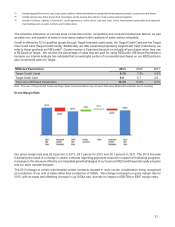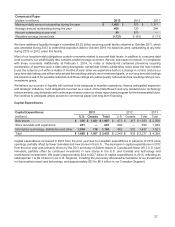Target 2013 Annual Report Download - page 35
Download and view the complete annual report
Please find page 35 of the 2013 Target annual report below. You can navigate through the pages in the report by either clicking on the pages listed below, or by using the keyword search tool below to find specific information within the annual report.30
Income taxes: We pay income taxes based on the tax statutes, regulations and case law of the various jurisdictions
in which we operate. Significant judgment is required in determining the timing and amounts of deductible and taxable
items, and in evaluating the ultimate resolution of tax matters in dispute with tax authorities. The benefits of uncertain
tax positions are recorded in our financial statements only after determining it is likely the uncertain tax positions would
withstand challenge by taxing authorities. We periodically reassess these probabilities, and record any changes in the
financial statements as appropriate. Liabilities for uncertain tax positions, including interest and penalties, were
$241 million and $280 million at February 1, 2014 and February 2, 2013, respectively. We believe the resolution of
these matters will not have a material adverse impact on our consolidated financial statements. As of February 1, 2014
we had foreign net operating loss carryforwards of $1,466 million which are available to offset future income. These
carryforwards are primarily related to the start-up operations of the Canadian Segment and expire between 2031 and
2033. We establish a valuation allowance for any portion of our deferred tax assets that we believe will not be realized.
We have evaluated the positive and negative evidence and consider it more likely than not that these carryforwards
will be fully utilized prior to expiration. Therefore, we have not established a valuation allowance. Income taxes are
described further in Note 21 of the Notes to Consolidated Financial Statements.
Pension and postretirement health care accounting: We maintain a funded qualified, defined benefit pension plan,
as well as several smaller and unfunded nonqualified plans and a postretirement health care plan for certain current
and retired team members. The costs for these plans are determined based on actuarial calculations using the
assumptions described in the following paragraphs. Eligibility and the level of benefits varies depending on team
members' full-time or part-time status, date of hire and/or length of service. The benefit obligation and related expense
for these plans are determined based on actuarial calculations using assumptions about the expected long-term rate
of return, the discount rate and compensation growth rates. The assumptions used to determine the period-end benefit
obligation also establish the expense for the next year, with adjustments made for any significant plan or participant
changes.
Our expected long-term rate of return on plan assets of 8.0 percent is determined by the portfolio composition, historical
long-term investment performance and current market conditions. Our compound annual rate of return on qualified
plans' assets was 10.4 percent, 8.3 percent, 7.2 percent and 9.2 percent for the 5-year, 10-year, 15-year and 20-year
periods, respectively. A one percentage point decrease in our expected long-term rate of return would increase annual
expense by $29 million.
The discount rate used to determine benefit obligations is adjusted annually based on the interest rate for long-term
high-quality corporate bonds, using yields for maturities that are in line with the duration of our pension liabilities. Our
benefit obligation and related expense will fluctuate with changes in interest rates. A 0.5 percentage point decrease
to the weighted average discount rate would increase annual expense by $30 million.
Based on our experience, we use a graduated compensation growth schedule that assumes higher compensation
growth for younger, shorter-service pension-eligible team members than it does for older, longer-service pension-
eligible team members.
Pension and postretirement health care benefits are further described in Note 26 of the Notes to Consolidated Financial
Statements.
Legal and other contingencies: We are exposed to other claims and litigation arising in the ordinary course of business
and use various methods to resolve these matters in a manner that we believe serves the best interest of our
shareholders and other constituents. When a loss is probable, we record an accrual based on the reasonably estimable
loss or range of loss. When no point of loss is more likely than another, we record the lowest amount in the estimated
range of loss and disclose the estimated range. We do not record liabilities for reasonably possible loss contingencies,
but do disclose a range of reasonably possible losses if they are material and we are able to estimate such a range.
If we cannot provide a range of reasonably possible losses, we explain the factors that prevent us from determining
such a range. Historically, adjustments to our estimates have not been material.
We believe the accruals recorded in our consolidated financial statements properly reflect loss exposures that are both
probable and reasonably estimable. With the exception of Data Breach-related loss exposures, we do not believe any
of the currently identified claims or litigation will materially affect our results of operations, cash flows or financial
condition. However, litigation is subject to inherent uncertainties, and unfavorable rulings could occur. If an unfavorable
ruling were to occur, it may cause a material adverse impact on the results of operations, cash flows or financial
condition for the period in which the ruling occurs, or future periods.
For Data Breach-related exposures, we are unable to reasonably estimate a range of probable loss in excess of the
recorded payment card network contingent losses. We believe that losses from the payment card networks in
excess of the amounts recorded in fiscal 2013 are reasonably possible, and that these losses could be material to
our results of operations in future periods, but we are unable to estimate a range of such reasonably possible
























